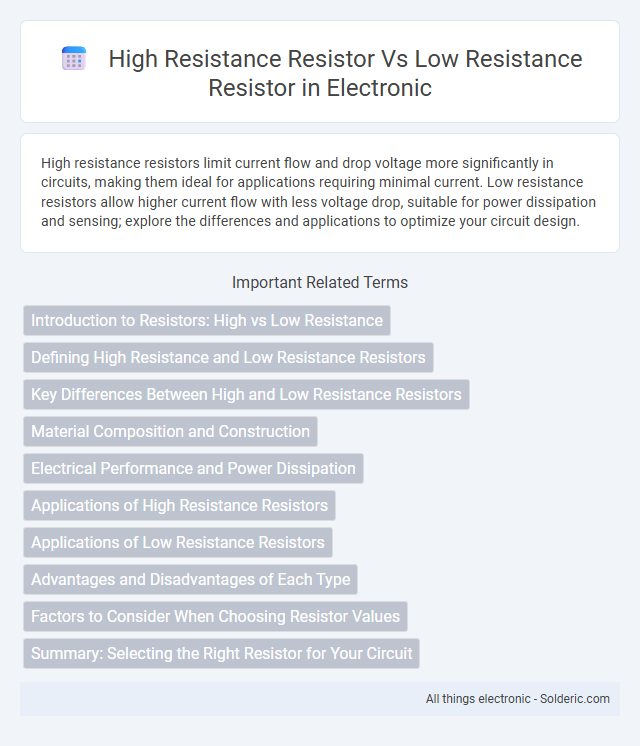High resistance resistors limit current flow and drop voltage more significantly in circuits, making them ideal for applications requiring minimal current. Low resistance resistors allow higher current flow with less voltage drop, suitable for power dissipation and sensing; explore the differences and applications to optimize your circuit design.
Comparison Table
| Feature | High Resistance Resistor | Low Resistance Resistor |
|---|---|---|
| Resistance Value | Above 1 MO (Megaohm) | Below 10 O (Ohm) |
| Current Flow | Limited, minimal current | Higher current allowed |
| Power Dissipation | Typically low power (0.25W or less) | Handles higher power (up to several watts) |
| Applications | Signal conditioning, voltage division, high-impedance circuits | Current sensing, power regulation, load applications |
| Noise | Higher thermal noise | Lower thermal noise |
| Size | Often smaller due to less heat generation | Usually larger to dissipate heat |
Introduction to Resistors: High vs Low Resistance
High resistance resistors typically range from kilo-ohms to mega-ohms, limiting current flow in sensitive electronic circuits and providing voltage division or signal attenuation. Low resistance resistors, often measured in milliohms to a few ohms, are used for current sensing, power dissipation, and load testing due to their minimal voltage drop and heat generation. Selecting between high and low resistance resistors depends on the specific circuit application, required power rating, and precision needed for effective electrical performance.
Defining High Resistance and Low Resistance Resistors
High resistance resistors typically have resistance values ranging from megaohms (MO) to gigaohms (GO), designed to limit current flow in circuits with high voltage or sensitive components. Low resistance resistors usually fall below one ohm (O) to several ohms, allowing higher current flow while providing minimal voltage drop. These resistors are selected based on circuit requirements such as power dissipation, precision, and the desired current-limiting effect.
Key Differences Between High and Low Resistance Resistors
High resistance resistors typically have values above 1 megaohm and are used to limit current flow significantly, providing protection in sensitive circuits and minimizing power consumption. Low resistance resistors, often below 10 ohms, allow higher current flow and are utilized in power applications, current sensing, and load testing where minimal voltage drop is crucial. The key differences include their resistance range, power dissipation capacity, and typical application scenarios in electronic circuit design.
Material Composition and Construction
High resistance resistors typically utilize materials like carbon film, metal oxide, or wire-wound alloys with careful layering to achieve precise resistance values and thermal stability. Low resistance resistors often employ thick metal films or metal foil constructions that provide minimal resistance and high power dissipation capability. Understanding the material composition and construction can help you select the right resistor for your circuit's performance and durability requirements.
Electrical Performance and Power Dissipation
High resistance resistors limit current flow more significantly, resulting in lower power dissipation compared to low resistance resistors, which allow higher current and consequently generate more heat. Low resistance resistors exhibit better electrical performance in high-current applications due to reduced voltage drop, while high resistance resistors excel in precision circuits requiring minimal current interference. Power rating and material composition critically influence thermal management and stability in both high and low resistance resistor types.
Applications of High Resistance Resistors
High resistance resistors, typically ranging from megaohms to gigaohms, are essential in applications requiring minimal current flow, such as voltage dividers, sensor circuits, and electrometer inputs. They are commonly used in leakage current measurement, high-impedance input stages of amplifiers, and insulation resistance testing to ensure accurate readings without loading the circuit. Their ability to control current in sensitive electronic devices makes them crucial in medical equipment, precision instrumentation, and electrostatic discharge protection.
Applications of Low Resistance Resistors
Low resistance resistors are essential in applications requiring precise current measurement and power dissipation, such as shunt resistors for current sensing in power supplies and battery management systems. They enable minimal voltage drop while maintaining accurate readings in high-current circuits, ensuring efficiency and reliability. Common uses include motor control, power amplifiers, and circuit protection, where low resistance minimizes energy loss and heat generation.
Advantages and Disadvantages of Each Type
High resistance resistors excel in limiting current flow and protecting sensitive components, offering advantages in signal filtering and voltage division, but they can generate more heat and reduce circuit efficiency under high load conditions. Low resistance resistors provide precise current sensing and minimal voltage drop, making them ideal for power management and load balancing, though they may not adequately limit currents in delicate circuits and can cause increased power dissipation in certain applications. Choosing between high and low resistance resistors depends on balancing factors like power rating, tolerance, noise generation, and the specific requirements of the electronic design.
Factors to Consider When Choosing Resistor Values
When selecting resistor values, consider the required current flow and voltage drop, as high resistance resistors limit current more effectively while low resistance resistors allow higher current flow. Power dissipation ratings are crucial; resistors with higher resistance typically dissipate less power but can generate significant heat if voltage is high, whereas low resistance resistors must handle larger currents without overheating. Tolerance and noise levels also influence the choice, with precision resistors preferred in sensitive circuits where minimal variation and low noise are essential.
Summary: Selecting the Right Resistor for Your Circuit
High resistance resistors limit current flow significantly, ideal for sensitive components or voltage division, while low resistance resistors allow higher current suitable for power regulation and load balancing. Your choice depends on the circuit's voltage, current requirements, and power dissipation needs to ensure optimal performance and protection. Proper selection prevents component damage and enhances overall circuit reliability.
High resistance resistor vs low resistance resistor Infographic

 solderic.com
solderic.com